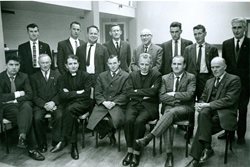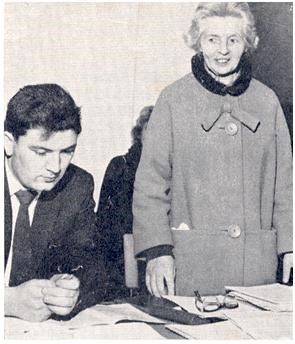The Story of the credit union
Community
4
min read
12 Oct 2020
.png?ext=.png)
This is the story of an idea, a great idea that is helping millions of people worldwide to lead better lives. In practice it’s simple and when properly implemented its effects be dramatic. Like most great ideas, it has stood the test of time.
The Irish credit union movement was founded as a result of the efforts of three dynamic, pioneering and entrepreneurial people namely Nora Herlihy,, from Ballydesmond, a teacher based in Dublin a teacher based in Dublin, originally from Ballydesmond on the Cork/Kerry border, Sean Forde an employee of Peter Kennedy Bakers, Dublin and Séamus P. MacEoin from Kilkenny a Civil Servant working in Dublin, originally from Kilkenny.
In Dublin in the 1950’s, they witnessed the effects of high unemployment: sickness, malnutrition, money lending, hunger, poor clothing, poor housing, and inevitably, emigration of one parent or of the whole family. In addition, state unemployment benefits were low and did not last indefinitely leaving many families in abject poverty.
The founders recognised the root of the problem as lying in the scarce availability and poor management of money and resolved to identify a system that would allow people to gain more control over their finances.
How the story began:
The credit union movement took an important step forward in its development with a meeting on December 9th 1953, in the Typographical premises 35 Lower Gardiner St., Dublin. At that meeting, of which Nora Herlihy was chair, a fuller understanding of what a credit union system might achieve emerged. Tomas O’Hogain who was at the meeting spoke of the need to cope with foreign interests and efforts to take over the Irish economy which in turn might place our independence in danger. In his view, a credit union would give individuals economic independence and responsibility by taking part in common activities and aims.
Impressed, Nora formed the Dublin Central Co-operative Society Ltd (DCCS) with Tomas O’Hogain on March 6th 1954. It was set up to create employment through workers co-operatives and neutralise at their source the forces which caused emigration. Along with the founding pair the following signed on; Séamus P. MacEoin, Joseph Carroll, Eugene O’Riordan, Michael Kavanagh, Desmond McGuigan, Margaret O’Riordan, Matthew O’Neill and Sean Forde. O’Hogain died soon after the society was registered and his place as chairman was filled by Séamus P. MacEoin.
A main function of the DCCS was the establishment and development of productive industry on a co-operative and co-partnership basis. To raise money, the DCCS founded a member’s savings and investment bank to finance the co-ops. However, their main aim to attract workers to the movement failed.
The Story from Abroad
Nora Herlihy started seeking assistance from others willing to take up the challenge. The response was encouraging and it included well wishers from abroad. Nora studied the results of credit union type organisations in the USA with information from CUNA and got extra literature to work on.
Under the influence of The National Co-Operative Council the DCCS became a Co-operative information service. Nora was asked to form a sub committee to examine the whole structure of credit unions. The sub committee of the council also included Sean Forde, Séamus P. MacEoin and Muriel Gahan of the Irish Countrywomen’s Association and Country Markets.
From now on, the roll on effect was impressive. A meeting of minds took place at the Daonscoil (folkschool) in Red Island, Skerries in 1957. The theme was co-operation and the week-long event organised by the Council was opened by the then Taoiseach, Éamon Mr de Valera. The Daonscoil provided the encouragement to the small band of credit union enthusiasts who now felt the time had come to turn theory into action.
Credit Union Extension Service
As a result of the Daonscoil, a few months later in September 1957, within the structure of the Council, the Credit Union Extension Service was born (CUES). CUES was established to review and co-ordinate the various activities in progress and to stage promotional talks. CUES was the launch pad for the credit union in Ireland. Its central figures included four women, a reflection of the powerful and often prominent role of women in ensuring the movements success from the beginning.
The CUES first ladies were Nora Herlihy, Muriel Gahan, and sisters Aingeal and Eileen ni Bhrion ably assisted by three of the movements male missionaries; Séamus P. MacEoin, Sean Forde and Tomas MacGabhann.
The First Credit Unions
In 1956 a government sponsored savings campaign prompted a co-operative in Dun Laoghaire, Co. Dublin, to set up a thrift society. When the campaign fizzled out the society was left with the problem of what to do with its members’ savings. On the advice of CUES it was reformed as the Dun Laoghaire Borough Credit Union – the first in Ireland. At its inaugural meeting it had thirty members whose common bond was membership of the co-op and business opened with the transfer of £80 from the thrift society to a credit union account in a local bank. Lieut.
In the city, meanwhile, the ni Bhrion sisters, Aingeal and Eileen – admirers of Canon Hayes, were arranging fireside chats to spread the message among their neighbours. The fruit of their endeavour was Ireland’s first residential type credit union…..Cumann Muintir Dun Oir. In an interview recorded in 1979 Aingeal ni Bhrion (Conway) said “Around December 1957 we were nearly ready to form our Credit Union…..one thing in the early days – we had more women interested than men. The first man interested was the Chairman of Donore, Mr Lawless.” She continued “We went around from door to door to tell people we were starting a credit union and holding a meeting in March. By that time a few more men had shown interest in assisting us. I think 54 came to the meeting. The sum of £5.12.6 in entrance fees at 2/6 each was taken in…..”
The inaugural meeting was held at the home of Mr & Mrs Lewis Lawless, 38 Hamilton Street in April 1958. Mr Lewis was the first Chairman, Oliver Hogan was Treasurer and Aingeal ni Bhroin was Secretary. The first weekly collection yielded £7. The credit union was officially registered as a Friendly Society entitled Cumann Muintir Dun Oir in August 1958.
Credit Union Legislation
In the delicate early stage of its development the movement was given yet another boost by and old friend from the National Co-operative Council, Sean Lemass, who was Minister for Industry and Commerce when the first credit unions were established. In December 1957, he set up a special committee to advise on legislative changes which would help to foster co-operative enterprise in the non farming sectors. Nora Herlihy was appointed to serve with twelve men. The deliberations of this committee were to form an important part of the process that led to the 1966 Credit Union Act, now the legal framework of the movement in the Republic of Ireland.
To the Country and Northern Ireland
After the formation of the first two credit unions in Dublin, the movement soon spread to the provinces; the third was in Clones, Co. Monaghan where it began as a study group led by a schoolteacher-priest, Rev Patrick Gallagher. Rev Patrick Gallagher was to become a major figure in the movement’s development in Northern Ireland. The study group was formed in September 1958. In March 1959 the Monaghan Trades Council held a meeting at which Nora Herlihy, Séamus P. MacEoin and Major General Costello spoke. Another meeting in June 1959 was organised and again Nora Herlihy spoke to gathered audience. The study group transformed into a credit union in December 1959 when its nine members subscribed £4 12s towards the venture. 
Then it was back to Dublin. Civil Service Credit Union was founded in January, 1960. It was organised by Séamus P. MacEoin who was assisted by his CUES and civil service colleagues. The Civil Service Credit Union was the first vocational credit union set up in Ireland.
Now it was Munster’s turn; here the inspiration came from Bishop Cornelius Lucey, another powerful voice for co-operative living. Ballyphehane Credit Union started in a church basement in July 1960 with thirty eight members subscribing £62.
The experience of most people in Derry in the 50’s and early 60’s was that of high unemployment. Banks and other financial institutions did not advance credit without substantial collateral or guarantees .Money lenders charged exorbitant rates of interest perpetuating the cycle of hardship. Consequently the ordinary working class people in the city had only very costly sources of credit available to them.
Six forward-thinking individuals, of which John Hume was one, decided there must be a source of affordable, reasonable credit for the ordinary person in Derry. They researched and discovered the fledgling Irish credit union movement and the well-established international movement. These six individuals pooled their combined savings of eight pounds and ten shillings and, in October of 1960, formally established Derry Credit Union - the first credit union in the city and the first to be founded in Northern Ireland.
Credit Union League of Ireland.
In early 1960, with numerous credit unions in business the movement had established a strategic base and its leaders began to build for the future with ever-increasing confidence. All soon realised the need for an umbrella agency to co-ordinate rules and to point the way ahead; and so the Credit Union League of Ireland (now the Irish League of Credit Unions) was set up at a meeting in Dublin, February 1960 and operated from the main living room of Nora Herlihy’s house in Dublin for many years.
The five founding unions of the League and the CUES each provided two directors; the first President was Rev Patrick Gallagher of Clones Credit Union; Sean Forde CUES, Vice President, Nora Herlihy CUES, Secretary, Capt. Michael Quinlan, Treasurer and a founder of Dun Laoghaire Borough Credit Union and Séamus P. MacEoin CUES and Civil Service Credit Union was Press Relations Officer.
In the following fourteen months, six more credit unions were affiliated to the League. Liptons Employees (later Shamrock) was the first of these, and it was also the first of many commercial credit unions that would follow along the path of Ireland’s industrial revolution over the next twenty years.
1966 Act
In 1966 President De Valera signed the Credit Union Act in 1966 into law. This was a watershed moment in the history of the Irish credit union movement. The signing into law of the Act led to an increased interest in credit unions throughout the country in the late 1960s. As membership of the League was increasing rapidly at this time and the volume of loan protection and life savings insurance was growing, the League board deemed it necessary to seek coverage in Ireland. 
In 1969, the League negotiated an agreement with CUNA Mutual Insurance whereby it would be the agent for CUNA Mutual in Ireland and Europe for the provision of loan protection and life savings insurance for credit unions. This meant that the League would now collect premiums, issue agreed insurance contracts, administer claims and development and maintain records
Let’s give credit where it’s most due….to the thousands of Irish men and women whose achievements in their own communities could never be recorded in a balance sheet. The Irish credit union movement, based on its philosophy of mutual self-help has played a key part in the social and economic history of the Irish people.
This blog has been written as part of our #HeresTheStory campaign which celebrates the credit union movement in the lead up to International Credit Union Day. This campaign features stories from the foundation of the credit union, key influencers in the movement and why this organisation just works for the people of Ireland.